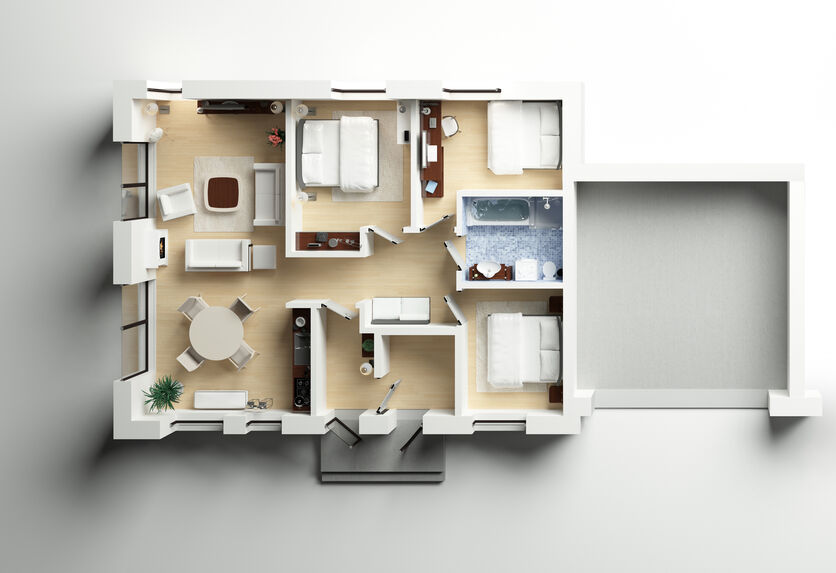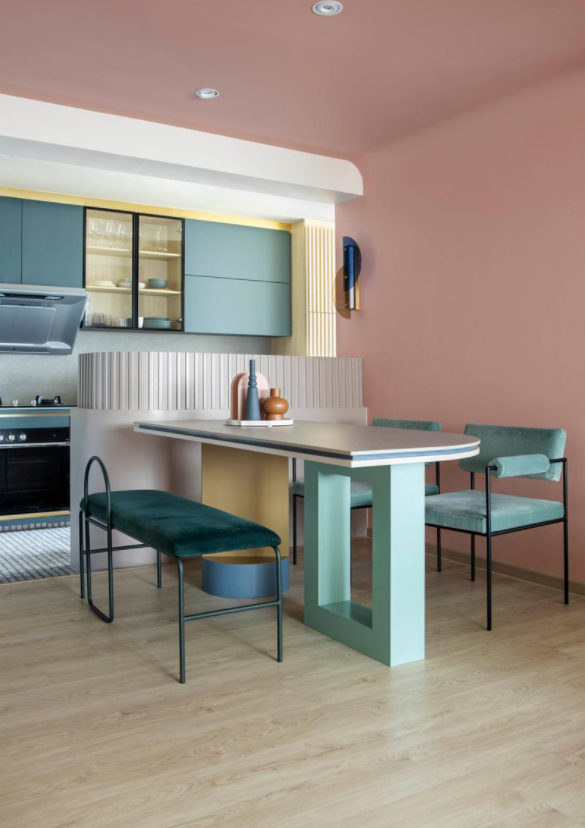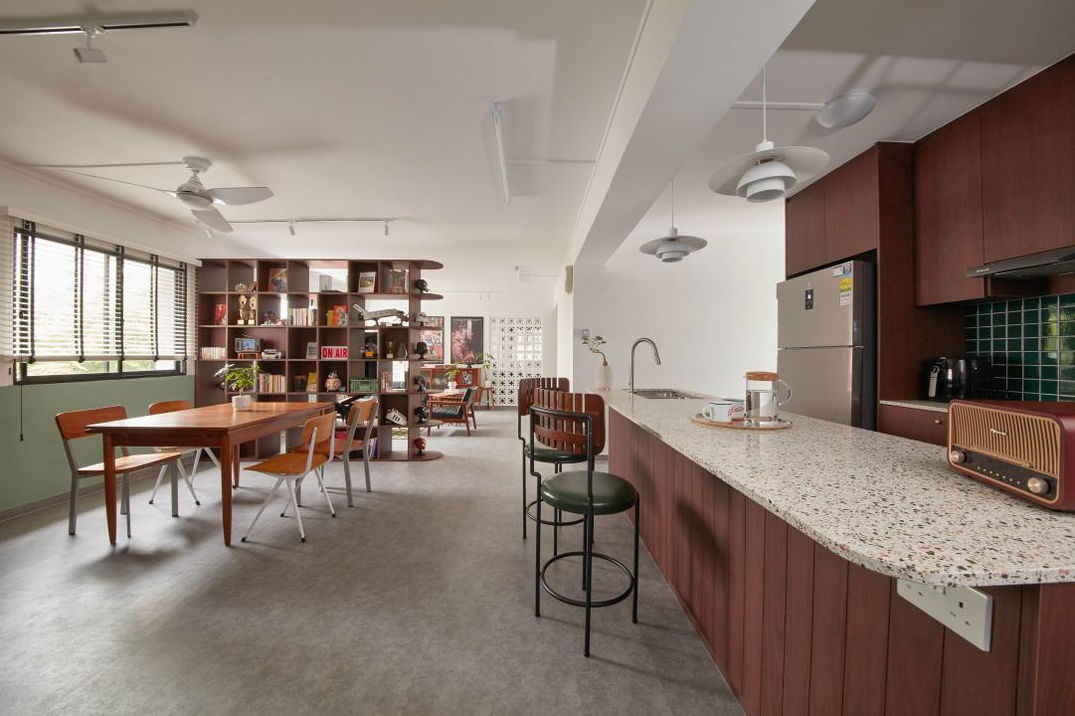
Those who grew up in Singapore often have the impression that space is a shrinking commodity. Looking at condo and HDB floor plans, it can be seen that HDB flats and condos have grown more compact over the years, with an increasing number of smaller flat types being built.
In order to accommodate households’ changing needs and use space more efficiently, HDB flat floor plans have also changed over the years. Let’s take a look at how the interior and exterior of HDB flats have changed, and how Singaporeans have responded to these changes.
HDB Floor Plans Over the Years

Source: Teoalida
Compared to the HDB flats of the past, new flat layouts have changed in the following ways:
|
HDB floor plan/flats in the past |
HDB floor plan/flats now |
|
Kitchens were bigger and wider |
Narrower kitchens, with a width of 2.2 to 2.4 metres |
|
Most windows face the north-south direction to maximise wind flow and reduce heat |
Aside from flats being north-south facing, architectural decisions are more optimised and windows are larger |
|
Bedrooms open directly into the living room |
Bedrooms and the shared bathroom open into a narrow corridor; segmented from living area |
|
3-room flat types used to be the smallest flat type |
More 2-room Flexi and 3-room flats; 3 room flats now the average flat type sold |
|
Bedroom windows open up to the HDB common corridor |
Bedroom windows no longer open up to common corridor |
|
Individual rubbish chute in flats’ kitchens |
Shared rubbish near lift landing |
|
HDB balconies more common |
HDB balconies are more rare, usually in DBSS or newer flat types |
1. Kitchen Sizes: Smaller and Narrower
Older flats used to have much bigger kitchens, but the HDB soon figured out that they were not using space efficiently. Their width often meant that there was a lot of space not being used.
Today’s kitchens tend to be smaller as households are now likely to cook less frequently. Kitchens in new flats are much narrower, with a width of about 2.2 to 2.4 metres. The elongated kitchen design enables the installation of cabinets on both sides for more storage.
For most flat types except for 2-room flats, the HDB also offers the option of getting rid of the wall in between the kitchen and living room.
Related article: Eco-friendly Kitchen Guide: Tips on Having A Low- or Zero-waste Kitchen
2. Direction of the Windows: Optimised with Bigger Windows, North-south Facing
In order to reduce heat, most HDB blocks are built to be north-south facing and avoid facing west. They are also built to maximise the flow of wind into the flat.
Newer flats tend to be more optimised in this regard than older flats, as the HDB has over time implemented more and more advanced techniques of analysis to optimise their architectural decisions. They are also equipped with wider and larger windows to improve ventilation and lighting.
Related article: What’s the Best House-Facing Direction in Singapore? The Good, the Not So Good, and the Bad
Likewise, rooms tend to favour a north-south orientation in order to minimise heat. Newer flats tend to be better at optimising the orientation of the room and hence might feel cooler or breezier.
3. Corridors: Bedrooms No Longer Open Directly into the Living Room

Older flats tended to have bedrooms that opened up directly into the living room, with no need for a hallway. For newer flats, the bedrooms and shared bathroom open out into a corridor.
4. Amount of Living Space: Smaller Flat Types Being Built
HDB flats across the same flat type have stayed roughly the same size over time, but the proportion of smaller flat types being built has increased.
3-room flats, which were previously the smallest flat type available are now the average new flat type being sold by the HDB. 2-room Flexi flats and 3-room flats, which were previously non-existent, now contribute to the falling average size of HDB flats.
External Changes of HDB Flats Over the Years
The external appearance of HDB blocks has changed over the years, too.
Most older HDB blocks used to share a common corridor running in front of flats on the same floor, with windows opening up into it. The common corridor has since been removed and HDB flat windows no longer open into the corridor but on the other side instead.
HDB residents previously all had a rubbish chute in their flats. Newer flats do not have this feature, likely to prevent pests in homes. Instead, residents use a shared rubbish chute located at the lift lobby.
There are also fewer HDB flats equipped with balconies, which are much more commonly found in older flats.
How People Prefer to Design Their Houses in 2021
The typical Singaporean household in 2021 is quite different from its counterpart in the 60s, 70s or 80s, and housing and layout preferences have likewise changed. Due to the smaller size of common areas, particularly in 4-room and smaller flats, many owners are now choosing to knock down walls in order to expand certain spaces.
Related article: 9 HDB Renovation Permits You Need When Renovating Your Home
A popular modification is to hack a single wall between the kitchen and the dining area or living room, which visually expands the common areas. Some also hack the wall between the master bedroom and an adjacent bedroom in order to accommodate larger furniture like a king-sized bed and desk or to install a walk-in wardrobe.
An example is the merging of the master bedroom and common bedroom in this 4-room Bidadari BTO flat. In place of walls, the owners put in glass French doors to serve as a partition between the bedroom ‘suite’ and walk-in wardrobe.

The sleeping area was originally a common bedroom, while the walk-in wardrobe area was the original master bedroom. Source: Qanvast

Does the rest of the house match? You bet. Click on the link to see before and after pictures of the renovation. Source: Qanvast
Open concept flats are becoming increasingly trendy as well, particularly amongst childless couples who do not need kids’ bedrooms. Most of the walls are hacked to create a large studio apartment, keeping only one bedroom for sleeping, which allows their home to appear more spacious.
The owners of this Wes Anderson-inspired 4-room BTO flat in Punggol carried out a major layout change. Not only did they knock down the walls between the two common bedrooms to expand their living room space, but also turned the original living room into their master bedroom. The original master bedroom was then turned into a walk-in wardrobe.

The kitchen of a renovated 4-room flat in Punggol. Click the link for before and after pictures, and the original and modified floor plans. Source: Qanvast

During the renovation and after pictures of the 4-room Wes Anderson-inspired BTO flat with a huge common area. Source: Qanvast
Some also buy older HDB resale flats and, during the renovation process, demolish most of the interior, building it back up from scratch and enjoying unparalleled levels of customisability.
For instance, Radio DJ Kunhua removed the wall dividing the master bedroom and study to create a walk-in wardrobe. Walls were also removed in his 5-room flat so that the common areas (i.e. kitchen and living and dining areas) flowed into one another in a single, open-concept space.

Click on the link to see before and after renovation pictures, as well as the original and modified floor plans of DJ Kunhua’s 5-room HDB flat. Source: Qanvast

Aside from rearranging the kitchen layout, the basin in the common toilet was moved outside of the washing area. Source: Qanvast
Related article: 5 Top Luxury Interior Design Trends to Look Out For in 2021/2022
Has the Floorplan of HDB Flats Improved?
HDB floor plans have evolved to become more flexible and customisable, in line with the growing desire of homeowners to design their flats to reflect their preferences. Newer flats can be more easily hacked as structural walls have been kept to a minimum within the flat.
The layout of the rooms and common areas has also changed from decade to decade, with the most common configuration for 3-room and larger flats now separating the bedrooms and bathroom from the living room. They must now be accessed via a corridor, whereas in many older flats it was common for bedrooms to open directly onto the living room and for the common bathroom to be accessible via the kitchen.
This offers greater privacy and also makes it easier for owners to hack walls and merge one or more rooms without making the layout awkward or negatively affecting the rest of the flat. As the number of couples with one or no children rises, and enduring work from home arrangements alter our needs, more are willing to reduce the number of bedrooms in favour of larger living spaces.
More FAQs about Floorplans in Singapore
How Many Rooms Are There in HDB Flats?
Most new HDB flats have a living room and dining area, a kitchen with an attached service yard, one or two bathrooms and one to three bedrooms.
How Many Bedrooms Are There in an HDB Flat?
2-room Flexi flats have one bedroom. 3-room flats have two. 4-room and 5-room flats have three bedrooms.
How Many Toilets Are There in an HDB Flat?
2-room Flexi flats have one toilet while 3-, 4- and 5-room flats have two; one in the common area, and one in the master bedroom.
For more property news, resources and useful content like this article, check out PropertyGuru’s guides section.
Are you looking to buy a new home? Head to PropertyGuru to browse the top properties for sale in Singapore.
Already found a new home? Let PropertyGuru Finance’s home finance advisors help you with financing it.
This article was written by Joanne Poh. A former real estate lawyer, she writes about property and personal finance and spends her free time compulsively learning languages and roller skating in carparks.

